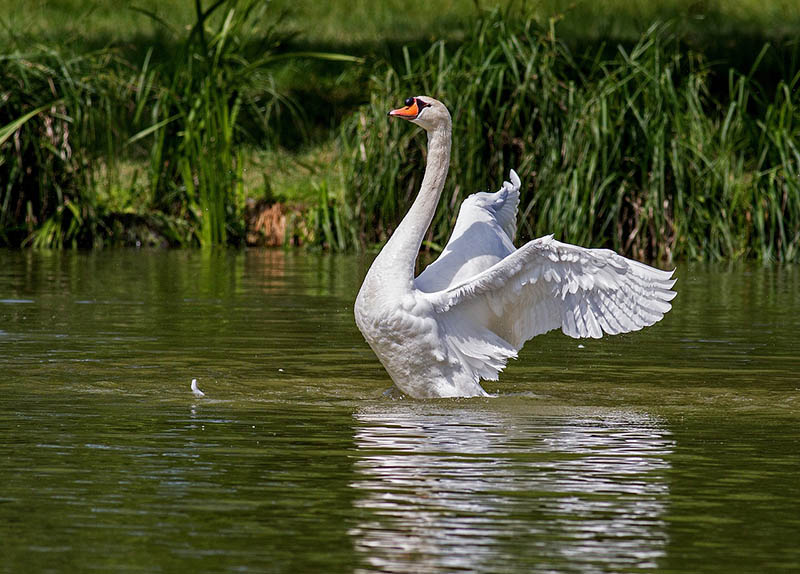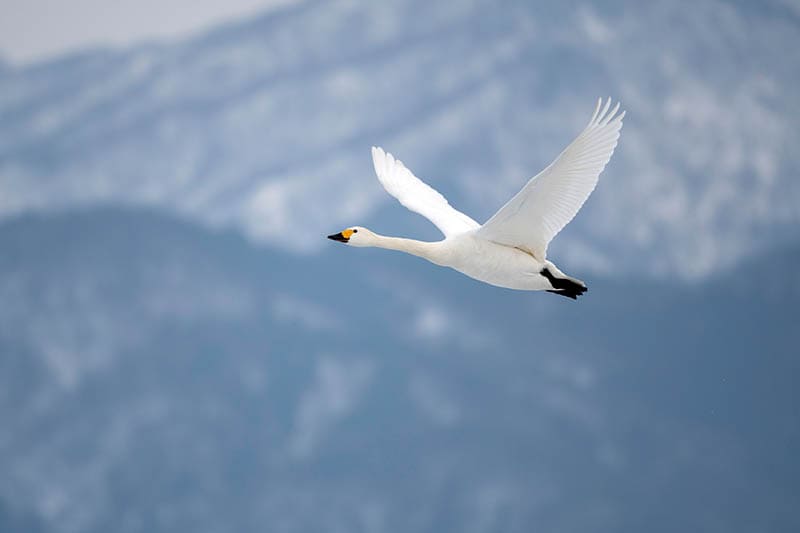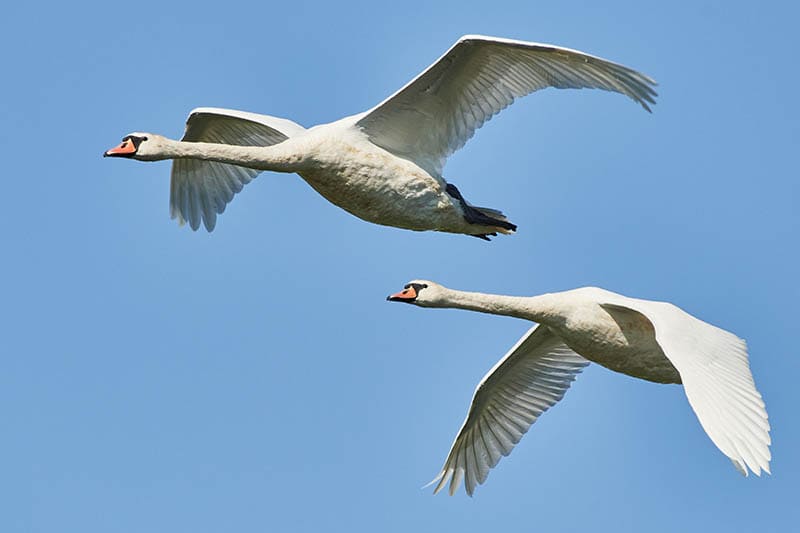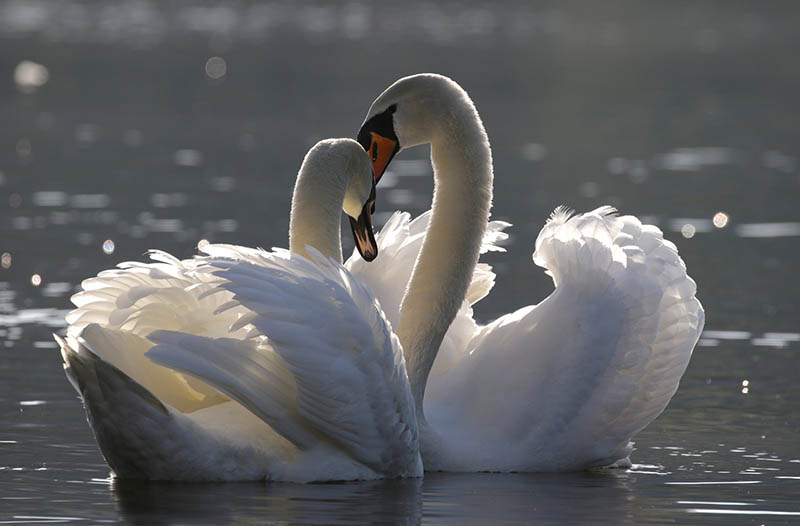Can Swans Fly? What You Need to Know!
Last Updated on

Swans live in warm areas with seasonal rainfall across the globe. They are beautiful, white birds with heavy bodies. In fact, swans are the largest living waterfowl in the family Anatidae and one of the biggest flying birds. There are several swan species, all of which can fly.
The flying range and height of swans may vary depending on the species. However, on average, they can reach heights of 6,000–8,000 feet with a speed of 20–30 miles an hour.
Some birds migrate partially, while others travel thousands of kilometers every year. You may have seen these birds swimming slowly, but they are fast flyers.

Do All Swan Species Fly?
Swans have different species living in different corners of the world. They mainly fly to find food sources, a partner for mating, or a place with a suitable climate for living. Swans usually travel to warmer places during the winter season to find food sources.
- Mute Swan
- Black Swan
- Whooper Swan
- Trumpeter Swan
- Black-necked Swan
- Tundra Swan
- Coscoroba
These swans can fly at different speeds and heights to varying ranges. While some fly towards the South, others travel to the North in search of food and a warm climate. So, you’re likely to see swans flying during the cold season.

How Far Do Swans Fly?
Some swan species, such as Whooper and Bewick’s swan, can fly thousands of kilometers yearly. Other species travel hundreds of miles daily.
Interestingly, some swans can fly for about 2,000 kilometers without needing to refuel. However, a few species stop in the middle to rest and eat and then continue their journey.
Here is a breakdown of the most common swan species according to their flying distances:
Bewick’s Swans

Out of all, Bewick’s swans fly to the maximum distance. They mostly travel within the UK or go a 3,500-kilometer route away from the Asian tundra and Russia. These swans fly continuously and only take short breaks for resting or feeding.
According to the currently available data, Bewick’s swans can fly as far as 4,000 miles or 6,437 kilometers within 10 weeks. Another record found that Bewick’s flew 831 kilometers on one leg in under 36 hours. The bird then flew 1,337 kilometers more in 15 hours with an average speed of 55 miles an hour.
Whooper Swans

Whooper swans also fly great distances. For instance, they usually travel from Scotland to Iceland without stopping anywhere. The distance measures 620 miles or 1,000 kilometers.
Black Swans

Black swans are non-migratory but nomadic birds. So, it’s currently unknown how far these swans can fly. These birds usually rest in open waters in the daytime and search for better food sources. Then, at night, they start flying.
Mute Swans

The Mute swans are the native birds in Europe and Asia. They are also one of the giant flying birds across the globe. The flying distance of Mute swans varies depending on whether they migrate.
Some of these birds stay in their territories throughout the year as long as they have a good food source nearby. The rest form winter flocks and travel to nearby rivers and lakes.
Mute swans living in the UK mostly remain in their birthplaces (less than 30 miles), while some fly shorter distances (mostly 60 miles). The European migratory species can travel to North Africa, India, and the Middle East.

What Is the Average Flying Speed of Swans?
The flying speed of swans is quite impressive, considering their body weight and size. They fly with an average speed of 20–30 miles an hour. Some swan flocks can even fly at 50–70 miles an hour.
The Mute swan has an impressive speed of a maximum of 50 miles an hour. They also have a wingspan of 238 centimeters.
How High Do Swans Fly?
Again, the height at which swans fly varies depending on the species. Most swans fly at an average elevation of 2,000–4,000 feet. However, this figure can go even higher during the migration period.
Radar recorded a group of Whooper swans traveling through Northern Ireland at 26,500 feet or 8,000 meters. In addition, Tundra swans can fly at an altitude of 6,000–8,000 feet with an average speed of 50–60 mph.

Do Swans Fly in a Specific Formation?
If you’re a birdwatcher, you’ll be amazed to see swans flying in flocks. These are one of the most-organized birds that fly in a specific formation, in a “V” shape or diagonal line when migrating in winter.
One swan leads the entire flock and guides it through the air. The leader also cuts through the wind, making it easier for other birds in the flock.
When the leading swan gets tired, they change their position and join the flock, and the other bird takes over the leadership position.
Do Young Swans Fly?
Swans fly from a very young age. Most birds start flying when they become 12 weeks old.
At this age, a swan’s feathers and muscles fully develop to support their body weight during flight. Swans make multiple flying attempts like every living being until they learn how to do it. Adult swans help their kids perfect their flying skills.
Mute swans wait 120–150 days to become strong enough to fly.
Do Swans Fly South in the Winter?
Swans prefer living in warm, temperate regions, so they usually migrate in the winter. They start their preparations for migration before the winter starts, preferably in the early fall.
Some swan species living in the Arctic regions, Europe, the UK, or North America, can’t survive cold winters. As soon as the fall begins, they look for places with lakes, plenty of water, and feeding grounds. These swans fly towards the South in the winter.
These birds travel in flocks in a V-shaped formation for long distances in cold weather. Every flock has one leader that guides the group when flying.
Swans start preparing for migration when winter ends, and spring begins. They don’t fly South this time but towards the North for breeding. Then, they return to their nests or build new ones and give birth to babies.

Do Swans Fly With Geese?
If you’re a beginner birdwatcher, the striking resemblance between swans and geese may confuse you. Both of these birds look alike because they belong to the same animal class, Anatidae. This is why swans and geese get along quite well and are often seen together.
It’s not yet confirmed whether these birds fly together or not. But it’s important to know that geese fly to the South in winter like swans. They also return to the North in the spring to breed. So, the high chances are that both of these birds fly together in flocks.
Like swans, geese are also large birds capable of flying for long distances at high speeds. Both eat almost the same diet but don’t nest or live together. So, whether or not swans fly with geese is still under research. It could be possible that they fly together, but they never breed or colonize with each other.

Final Thoughts
Swans are beautiful, large birds with a striking white color. These birds are known as one of the heaviest birds that can fly.
You’ll come across several swan species, each with different characteristics, flying speeds, and heights. All types of swans fly. The average flying height of swans is between 6,000–8,000 feet. The average speed is recorded to be around 20–30 miles an hour. However, Bewick’s swan can reach speeds of approximately 55 miles an hour.
Most swans are migratory, but some prefer to live within their birthplaces or travel shorter distances to nearby lakes.
Featured Image Credit: Helmut Stirnweis, Pixabay
Table of Contents
About the Author Jeff Weishaupt
Jeff is a tech professional by day, writer, and amateur photographer by night. He's had the privilege of leading software teams for startups to the Fortune 100 over the past two decades. He currently works in the data privacy space. Jeff's amateur photography interests started in 2008 when he got his first DSLR camera, the Canon Rebel. Since then, he's taken tens of thousands of photos. His favorite handheld camera these days is his Google Pixel 6 XL. He loves taking photos of nature and his kids. In 2016, he bought his first drone, the Mavic Pro. Taking photos from the air is an amazing perspective, and he loves to take his drone while traveling.
Related Articles:
Can You Use Binoculars to Look At Stars? How to Choose the Right Pair
10 Types of Hummingbirds in Arkansas (With Pictures)
8 Types of Hummingbirds in Nebraska (With Pictures)
5 Types of Hummingbirds in Idaho (With Pictures)
3 Types of Hummingbirds in Mississippi (With Pictures)
8 Types of Hummingbirds in Kansas (With Pictures)
5 Types of Hummingbirds in West Virginia (With Pictures)
5 Types of Hummingbirds in Ohio (With Pictures)
